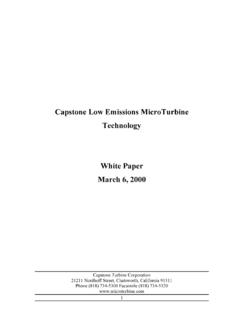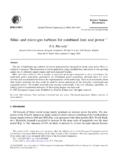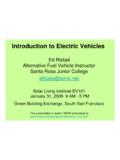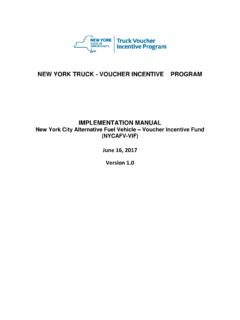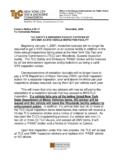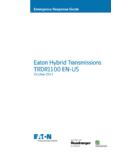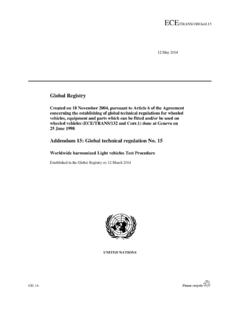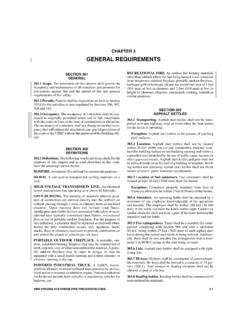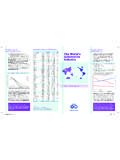Transcription of The use of Microturbine generators in hybrid electric vehicles
1 +,/TechDevelopments LimitedThe use of micro turbine generators inhybrid electric vehiclesHILTech Developments Limitedemail site 2000 HILTech Developments Limited all rights reservedSeptember 2000 Page 1 of 9 IntroductionThis document briefly describes some ideas for ultra-low emission power trains using a micro turbine in aseries hybrid configuration. Over the last decade or so, there has been considerable debate in the technicalpress describing the relative merits and drawbacks of parallel, series and more complex drive , most of this debate has been based on the implication of using diesel or petrol engines as thethermal engine s activities in hybrid systems are focused on three prime sources of power for series hybrid vehiclesthey are: fuel cells - rotary engine and micro turbines.
2 The actual power train design is dependent on a widenumber of factors and can result in complex systems. For example; under certain commercialcircumstances, we can include both a small PEM fuel cell and a thermal engine system in one document however, is mainly focused on the use of micro , HILTech considers a series hybrid solution is a preferred solution to current power train design forthe following reasons: ait overcomes the major draw back of micro turbines namely, the limit to the number of times that theycan be started up and shutdownbit allows us to offer a modular power train solutioncit enables the micro turbine to run at constant speed and maximum efficiency whereby the Microturbine is rated to provide the average load and the batteries / super capacitors provide instant peakpower for acceleration gradients allows for black box fast interchange serviceabilityThe design algorithm is rated to allow for the constant recharging of the batteries providing the best overalleconomic solutionWhat is a micro turbine ?
3 micro turbines are small combustion turbines approximately one third the size of its equivalent diesel enginewith outputs of 25 kW to 500 kW. They evolved from automotive and truck turbo-chargers, auxiliary powerunits for air planes, and small jet engines and comprise a compressor, combustor, turbine , and recuperator. micro turbines can run on a number of fuels which include; hydrogen, CNG / LPG, alcohol, Kerosene,recycled oil, possibly vegetable oil all which reduces dependence on diesel or petrol. Indeed using CNG /LPG the micro turbine is a micro gas turbine . It is the replacement of a conventional thermal engine by amicro turbine which is the significant technical innovation described in this turbines offer a number of potential advantages compared to other technologies for mobile powergeneration.
4 These advantages include:aa small number of moving parts,bcompact size with the potential to be located with strict space limitationsclight-weightdlower energy costselower emissions with multi-fuel capabilityfimproved overall vehicle design due to weight and size savingsgthe opportunities to utilize otherwise waste fuels HILTech Developments Limited all rights reservedSeptember 2000 Page 2 of 9 Turbines are classified by the physical arrangement of the component parts: single shaft or two-shaft, simplecycle or recuperated, inter-cooled, and reheat. They generally rotate at over 60,000 rpm. The schematic below shows a typical overall can be oil but HILTech uses manufacturer which fit air bearings only.
5 A single shaft is the morecommon design as it is simpler and less expensive to build. Conversely, the split shaft is necessary formachine drive applications, which does not require an inverter to change the frequency of the AC turbines can also be classified as simple cycle or recuperated. In a simple cycle, or unrecuperated, turbine , compressed air is mixed with fuel and burned under constant pressure conditions. The resulting hotgas is allowed to expand through a turbine to perform work. Simple cycle micro turbines have a lower cost,higher reliability, recuperated units use a sheet-metal heat exchanger that recovers some of the heat from anexhaust stream and transfer it to the incoming air stream.
6 The preheated air is then used in the combustionprocess. If the air is preheated, less fuel is necessary to raise its temperature to the required level at theturbine inlet. Recuperated units have a higher thermal to electric ratio than unrecuperated units and, inaddition, can produce 30-40 percent fuel savings from materials, such as ceramics and thermal barrier coatings, are some of the key enablingtechnologies to further improve micro turbines. Efficiency gains can be achieved with materials likeceramics, which allow a significant increase in engine operating temperature. HILTech Developments Limited all rights reservedSeptember 2000 Page 3 of 9 Because of their compact size, low operational and maintenance costs, automatic electronic control, microturbines are ideal for hybrid vehicle applications however because of their relatively high capital cost theirmarkets are considered to be:apublic service vehicles (buses)bheavy commercial trucks of say >10 Tonne payloadclight rail systems where public utility supply is unreliabledshunting locosThe diagram above shows a typical series hybrid system configuration, its advantages are.
7 Ultra low weight a typical 100kW (134HP) turbine system weighs about 640 kg very small dimensional enveloptypically over 25% thermal efficiencyvery low maintenance requirement and ease of maintenancedirect drive to generator eliminating the need for gearboxback-box installation allowing for service exchange reducing vehicle off road maintenance delayconstant speed thus narrow noise hysteresismulti fuel capability HILTech Developments Limited all rights reservedSeptember 2000 Page 4 of 9 The efficiency of turbine systemsThe micro turbine has a base twenty-six to twenty-eight percent (26 / 28%) thermal efficiency however, this iscompensated by weight saving and overall hybrid system efficiency.
8 The thermal efficiency can be increasedto typically 31/32% by using waste heat absorption technology to power air conditioning or vehicle spaceheating or used to power a Rankine cycle to generate more electrical following table (overleaf) illustrates the technology comparison between a micro turbine generatorpowertrain solution against the current PEM fuel cell state-of-the-art and a conventional CNG poweredthermal turbine / generatorPEM Fuel cellCNG engine/generatorLifetime in operating hours>20,000>2,000~13,000 Moving parts number of unitsrotor onlyblower / pump>50 Thermal managementexhaust emissionswater cooledwater cooledOn-board fluid storagenonewater/antifreezewater antifreeze andlubricating oil Electrical generation yesyesyesEmission control / treatmentyesnoyesFreeze tolerantyesnoyes>60OC ambient operationnot provennot provenyesThere is on-going development by the micro turbine suppliers in the application of more advanced materials, ceramics and thermal barrier coatings.
9 These are some of the key enabling technologies to furtherimprove micro turbines. Efficiency gains can be achieved with ceramics which allow a significant increase inengine operating temperature. HILTech Developments Limited all rights reservedSeptember 2000 Page 5 of 9 hybrid power train applicationsTypical applications include:cars, trucks and public service vehicles (buses)locos for use in mining, shunting (switching) and other areascertain industrial vehicles including materials handlingtrolleybus auxiliary power unitsmilitary applicationsIn using an ultra-low weight, all-composite public service vehicle body technology, the following tableillustrates the weight comparison of a micro turbine electric power train with a conventional diesel enginedhaving the same payload capability.
10 The table also indicates the numbers for a current state-of-the-art conventional steel chassis bus forcomparison:Kerb Weight kgPassengerpayloadkgTotal Weight kgConventional diesel poweredconventional steel chassis busa7,5003,50011,000 All-composite body bus with dieselengine power trainb5,9003,5009,400 All-composite body bus with Microturbine and battery packc5,1003,5008,600 WEIGHT REDUCTION b / aKerb weight 21%Total Weight REDUCTION c / bKerb weight Weight REDUCTION c / aKerb weight 32%Total Weight 22%These weight savings represent direct saving savings in fuel costs and pollution over and above the energyefficiency savings by using a hybrid power train over a conventional diesel system.
